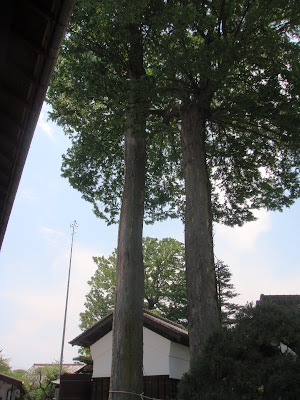Wendy Iwamoto.


After Wendy sent off her 2 children, Joshua and Airin and hubby to Yokota Air Base for the kid's school field trip to Disneyland, Wendy drove us around Fussa area and to then to Ishikawa Brewery to watch how 手造りの酒 「多満自慢」sake is made.Ishikawa brewery has been around for 120 years and yet so well preserved ( free entrance fee) Ishikawa Brewery, with its premises surrounded by tall whitewashed walls, is located in Kumagawa of Fussa City, in the western part of Tokyo. The history of Ishikawa family started in the Muromachi Period (1333 - 1573 A.D.). Ishikawa Brewery respect their buildings because they want to preserve the culture of sake brewing and culture of Japan.

First stop is the Hongura:

In this Hongura building, first-quality water and rice are used to make sake. The building is a storehouse built in 1881. It stands 13.25 m high with a frontage of 25.2 m and depth of 31.5 m. The roof is covered with tiles, and its area is as broad as 990 square meters. It is said that a building on such a scale is rare for existing wooden kura buildings. Such a kura has been essential for sake brewing for many years because a steady temperature is maintained throughout the year. The process of sake brewing has been modernized, the temperature is easier to control.
Next: Sake cellar

In the centre of the premises are two 400-year-old zelkova trees, called Meoto Keyaki 夫婦欅. At the root of these trees, Daikokuten, the god of rice, and Benzaiten, the goddess of water, are enshrined. Sake is made from rice and water, and quality rice and fresh water are essential for making excellent sake. Consequently, Ishikawa Brewery gives a great deal of devotion to the god of rice and goddess of water. The source water is pumped from a point 150 m below the ground. This water is the middle-hard water of the Chichibu-Tama Paleozoic formation and very suitable as source water for sake brewing.



Beautiful japanese garden surrounding the brewery:



Next destination : Showa Kinen Park Entrance fee is 400 yen for adult and we hop on a "train" that carry us around the park since we were rushing for time since the train driver told us that the black cloud was coming towards our direction and it would soon rain. Fees for riding the train for hop on and hope off is 500 yen. View that we saw as we ride around the park and in the Japanese Garden
Poppy flowers:

Train that we used to go round the park:


Beautiful bonsai:

Bonsi master who is very eager to explain to us how to make bonsai in japanese.

Lunch was at Ootoya大戸屋 @ Seiyu, Fussa. Very heavy lunch where you can order 5 grain rice of size S, L or XL. Size of rice can be upgraded at no extra charge so obviously we all ordered XL since it was 3 pm + at that time, which was also our lunch cum dinner of the day. Not too expensive at 650 yen a set with free flow of green tea and iced water. service at the shop was 6 *. The lady at the shop was really really nice , it was a pity that we can't speak and compliment her in japanese.





No comments:
Post a Comment